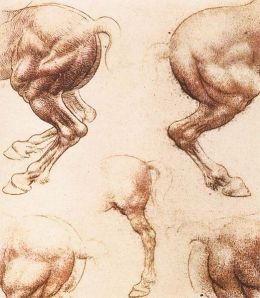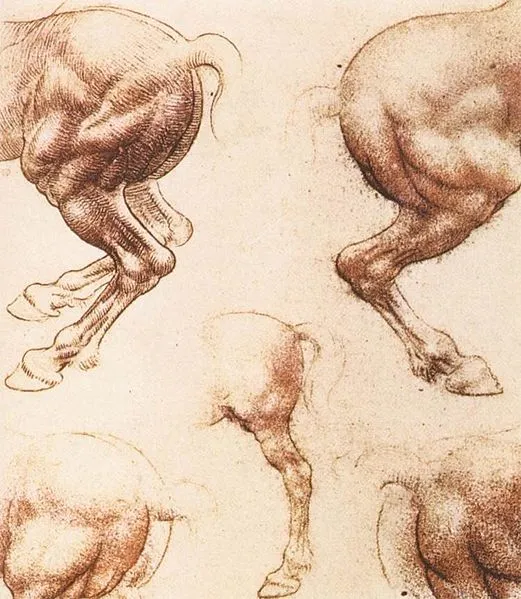Research point: Look at how Renaissance masters such as Leonardo and Dürer depicted animals
During the Renaissance period (14th-17th centuries) Europe became the academic heart of the world with Renaissance scholars absorbing the knowledge acquired from other older cultures such as vanishing the Islamic world. Like many other areas of study during this period, both biology and natural science became progressively more specialized and began to take on their own identity.
The Renaissance began a cultural revolution that seemed to be driven by art and science at this time was no different, in fact it was the artists and sculptors of the Renaissance period seeking perfect realism in their work that brought anatomy and biology to the forefront of all scientific areas.
Renaissance artists were the first to dissect plants and animals for a better understanding of the living world. From this artists were able to create more energetic and realistic works of art and make the connection between the structures of animals and humans; Leonardo da Vinci was undoubtedly one of the first scholars to do just this.
Leonardo da Vinci (1452-1519)
These days described as the first animal rights activist Leonardo da Vinci would often go to the markets and buy caged animals to set them free. In several of his works Da Vinci combined art with science. This combination of art and science is especially clear in his depiction of animals.
To render the animals in his works with scientific precision Leonardo not only studied the anatomy of the animals but also their physiology. But too really depict them with scientific precision he performed dissection on a number of animals as well as studying their movement in their natural habitat.

Nowhere is it more obvious as in his ‘Cavillo di Leonardo ’ (Leonardo’s Horse 1490 c) right. Not only has he managed perfectly reproduce the animals stance and bowed head but the wonderful muscle tone and folds around the neck.

In ‘Study of horses’ red chalk on paper 1504-6 which I think is actually a ‘ A Study for the Battle of Anghiari’ he focuses on the horse’s hind legs especially on how the defined muscles and tendons giving an impression the horse’s legs are buckling under weight. To me this is a prime example of how his scientific studies helped him to achieve this standard of realism.
Albrechct Durer (1471-1528)
Born in 15th century Nuremberg, Germany into the Northern Renaissance period, Albrecht Dürer was the son of a goldsmith who taught his son to draw, hence Albrecht’s appreciation of fine detail. Dürer is undoubtedly one of the greatest oil painters of the Northern Renaisssance but is also famous for his superb watercolours as well as woodcut prints and engravings.
Until the superb quality of George Stubbs’s work elevated animals in art in the 18th century animals were not thought of to be ideal subjects and the drawing of animals was considered to be merely a demonstration of an artist’s technical skill. However almost two centuries before Stubbs, Dürer began to view animals with the attention they deserved and demonstrating this with an array of watercolours and woodcut prints that over time have become increasingly popular and widely reproduced.

Albrecht Dürer was a familiar name to me and I was especially familiar with his painting ‘Wing of a Blue Roller 1512′ an image I have come across time and time again, and it’s a always been a goal of mine to create something similar being inspired by this wonderful piece.
The painting Is a perfect example of his exceptional drawing skill, ‘he uses watercolor to delicately blend the soft graduating color of the plumage and overpaints linear detail with gouache (an opaque watercolor) to pick out the jagged edges of the feathers.’ [3] He has managed to capture the contrasting textures of the feathers and down of the wing perfectly with so much realism that you can almost feel it.

Dürer created this pen and ink drawing of the Indian rhinoceros based on notes and a sketch by an unknown artist from Lisbon who had obviously been a traveler and seen the animal with his own eyes. However Dürer had never seen this animal for himself and recreated the drawing enhancing the anatomy of the animal by adding an extra horn to the Rhino’s back. The rhinoceros had not been seen in Europe since Roman times and Dürer’s image of the animal was generally accepted as being anatomically correct until the 18th century. Again, even though he had never seen the animal for himself, he has almost managed to recreate the exact texture of the animal.
[1] http://www.medievalists.net/2011/05/10/leonardo-da-vincis-representation-of-animals-in-his-works/
[2] http://explorable.com/renaissance-biology
[3] http://www.artyfactory.com/art_appreciation/animals_in_art/albrecht_durer.htm
